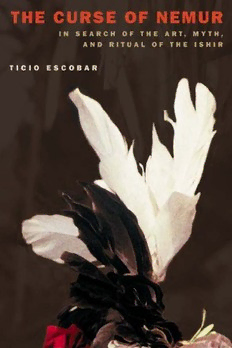
The Curse of Nemur: In Search of the Art, Myth and Ritual of the Ishir PDF
Preview The Curse of Nemur: In Search of the Art, Myth and Ritual of the Ishir
THE CURSE OF NEMUR Illuminations: Cultural Formations of the Americas John Beverley and Sara Castro-Klarén, Editors THE CURSE OF NEMUR IN SEARCH OF THE ART, MYTH, AND RITUAL OF THE ISHIR Ticio Escobar Translated by Adriana Michele Campos Johnson Foreword by Michael Taussig UNIVERSITY OF PITTSBURGH PRESS Published by the University of Pittsburgh Press, Pittsburgh, Pa., 15260 Copyright © 2007, University of Pittsburgh Press All rights reserved Manufactured in the United States of America Printed on acid-free paper 10987654321 0-8229-4293-3/ 0-8229-5937-2 Library of Congress Cataloging-in-Publication Data Escobar, Ticio, 1947- [Maldición de Nemur. English] The curse of Nemur: In search of the art, myth, and ritual of the Ishir / by Ticio Escobar ; translated by Adriana Michele Campos Johnson ; foreword by Michael Taussig p. cm. — (Illuminations: cultural formations of the Americas) Translation of La maldición de Nemur. Includes bibliographical references and index. ISBN 0-8229-4293-3(cloth: alk. paper) — ISBN 0-8229-5937-2(pbk.: alk. paper) 1. Chamacoco mythology. 2. Chamacoco Indians—Religion. 3. Chamacoco Indians— Rites and ceremonies. I. Title. F2230.2.C5E8313 2007 398.2'08998—dc22 2006025144 CONTENTS List of Illustrations vii Foreword ix Translator’s Introduction xv Acknowledgments xix Introduction 1 1 The Great Myth 15 2 Feathers and Featherwork 65 3 Corporal Painting 117 4 The Rite 153 5 The Path of the Shamans 211 6 The History 261 Notes 287 Works Cited 293 Index 295 ILLUSTRATIONS 1. Area of distribution of the current Ishir settlements 7 2. Tomáraho man representing ananábseragainst the backdrop of the Paraguay River 14 3. Depiction of Nemur and Ashnuwerta 31 4. Depiction of an anábserteaching an Ishir to hunt 34 5. A representation of Nemur 43 6. Clemente López, Ebytoso shaman, crowned with a feather headdress andlarge neck-guard 64 7. Ishir man representing the anábserHo-Ho in a ceremonial scene 84 8. Detail of a man ceremonially adorned with a bracelet, belt, and double skirt of feathers 102 9. Bruno Sánchez Vera adorned with a crown of feathers 111 10. Three youths recently initiated 112 11. Feliciano Rodríguez ready to play the role of guardian of the anábser Honta Abich 116 12. Detail from a scene of body painting 135 13. The impression of hands on the back of an officiant at the initiation grounds 136 14. A young girl with facial paint 139 15. Portrait of Luciano Martínez, Tomáraho sky shaman 145 16. An Ishir man painting his legs black before he enters the ceremonial circle 149 17. Female ritual of mourning 152 18. A woman of the Tomáraho clan ritually confronts the anábser Honta Abich 186 vii 19. Ceremonial march of the anábsoroWaho 193 20. Scene from an Ishir ceremony, where the anábserKaimo is being represented 196 21. Characters personifying the anábserWo 202 22. Tomáraho man spinning the great feathered bundle called kadjuwerta 205 23. Scene from the ritual of Wahé 207 24. ATomáraho shaman,Aligio Estigarribia. 210 25. Ramiro Jara, Ebytoso shaman,painting his body 235 26. A shaman invoking the power of the wasps 238 27. The author records a myth 260 28. Portrait of Vicenta Maura 271 29. Edgar, chief of María Elena, examines the photograph of a woman 279 30. Children whose backs are painted with black lines 285 viii ILLUSTRATIONS FOREWORD If you want to learn something about color and feathers—from an Indian point of view—read this book. It also happens to be of service to literature, to art criticism, to the comparative study of religions, to shamanism, the prac- tice of anthropology, and above all to the rethinking of the role of Native Americans in shaping the self-understanding of the Americas. It is a precious document, an extension of the delicacy and uniqueness of the thought it treats. It is as valuable for the way it goes about its task—an anthropology of anthropology, if you will—as for what it says. Working his way through stories of how the world came to be, Ticio Escobar goes on to describe the art of featherwork, bodypainting, and ritual in the densely detailed shamanism that exists among the Ishir of the Gran Chaco of Paraguay. The subjectmatter is exotic, which is to say true, in this case, to the reality depicted. It is also unique. I know of very little written on featherwork and body painting in the ethnographic literature—let alone in- tegrated so honestly and hence beautifully into myth,ritual,and native aes- thetic theory. As regards the latter, Escobar provides the reader with copious and stupendous material on the use of color, andfor that alone the book de- served to be translated.A final chapter offers a series of random documents intended to give a sense of the book’sorigins and the recent history and phys- ical health of these native people. It is a shocking history, especially in regards to the role of the Paraguayan army in the Chaco War of the 1930s,and the role over several decades of the U.S.-based New Tribes Mission. The Ishir have evaded the missionaries hell-bent on destroying their mythic and ritual life. Some worked for a tannin company. Others cut down trees to sell to logging companies. From the stories collected here we learn of non- Indians using the promise of measles vaccine to lure Indians into working for them while dying from measles. Priests do the same. Alcohol was a means of payment and prostitution of Indian woman to Paraguayan soldiers was a sup- plementary form of income. ix
